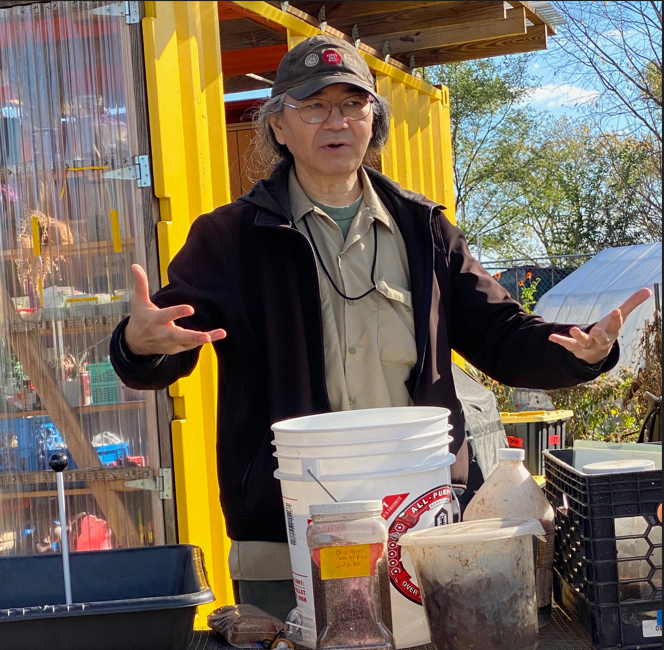Why We Need To Connect With The Land
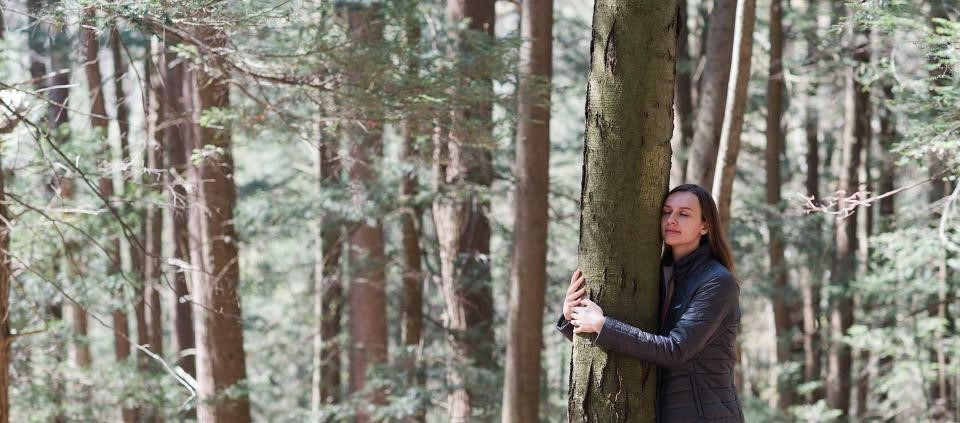 By Neenah Payne
By Neenah Payne
This article was initially called “Steps To Become More Food Secure”. As My Gardening Articles section on my Urban Garden Revolution website shows, I’ve taken several steps over the last two years to increase my food security in light of the growing droughts and supply chain problems. In 2021, I also submitted my Green Roofs Proposal when I ran for the board of my co-op to help make our 12 building co-op more food secure.
However, the article was renamed after I took the NYC Master Composting Certificate Program (7 Workshops, 2 Field Trips, and 30 Hours of Volunteering) earlier in the spring and summer and completed the 10-week Earth Matter Compost & Farm Apprenticeship Program on Governors Island, NY this fall. I discovered that what I had learned had transformed me in ways I had not anticipated. What began as steps to address food insecurity evolved into a fascination with and love of the land!
I took the 7 Workshops at the Brooklyn Botanic Garden. Six of them were indoors and one included a tour of the garden’s compost facilities. The 7 Workshops correspond to the seven chapters of the 223-page NYC Master Composter Manual. So, this was a more academic experience. My field trips were to the Queens Botanical Garden and Governors Island. At the Graduation Ceremony on November 3, graduates each received a Certificate and T-shirt and had the option of receiving the Manual. This program provided a great foundation for the Earth Matter Apprenticeship.

Earth Matter 10-Week Apprenticeship Program
Marisa DeDominicis, Manager of the Soil Start Farm, leads the Earth Matter Apprenticeship Program. Marisa has a BA in Business and Organizational Communications from Emerson College, Boston. She worked for the Trust for Public Land (TPL) as an environmental educator and project manager for 18 years. Her duties there ranged from leading educational systems on garden design and construction, and managing both community engagement and construction of infrastructural improvements for 68 community gardens which are now part of the Brooklyn Queens, Manhattan, and Bronx Land Trusts. Apprentices must belong to a GreenThumb community garden.
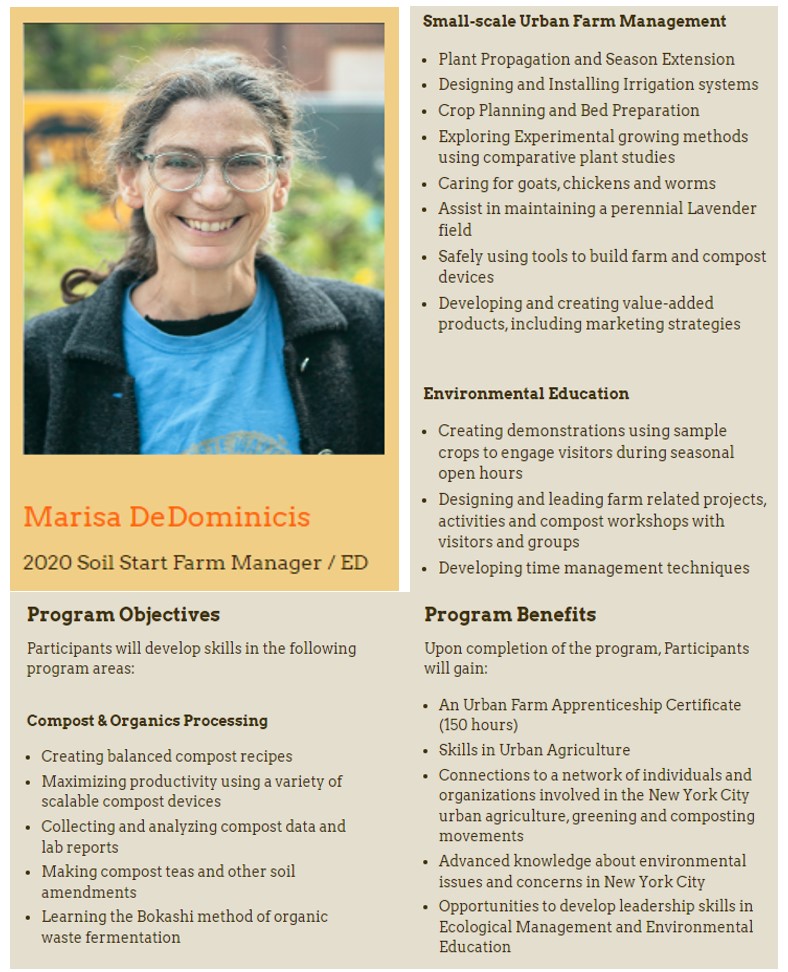
Marisa is co-author of Chicken Composting on Governors Island — a fun fact-packed booklet.
 Chicken Composting on Governors Island
Chicken Composting on Governors Island
Earth Matter includes the following projects:
- NYC Compost Project (hosted by Earth Matter)
- Zero Waste Island Initiative
- The Lavender Field
- Soil Start Farm
Elena D’Amanda: Farm Assistant & Educator
Elena D’Amanda, a graduate of the Earth Matter Soil Start Farm Apprenticeship Program and the Farm School NYC. co-leads the Apprenticeship Program. Elena completed Farm School NYC, a year-long program which meets twice a week (Tuesday evenings and Saturdays). Classes take place in a wide variety of city gardens, farms, and unique classroom spaces to engage in city-specific education. The Citywide Program is an urban agriculture program which begins with botany and food justice before immersing in courses that follow the growing season at partner sites.
Elena is an EBT Manager at Grow NYC. Her experience in these programs strengthened her commitment to building community around equitable food access and nurturing a reciprocal relationship with the Earth. Elena emailed us information prior to each week to tell us how to prepare — by watching videos or checking other materials.
Note: The 10-week Earth Matter Apprenticeship Program will be offered in the Spring starting in March. A 20-week course starts in May. Check the Earth Matter site next year to register.
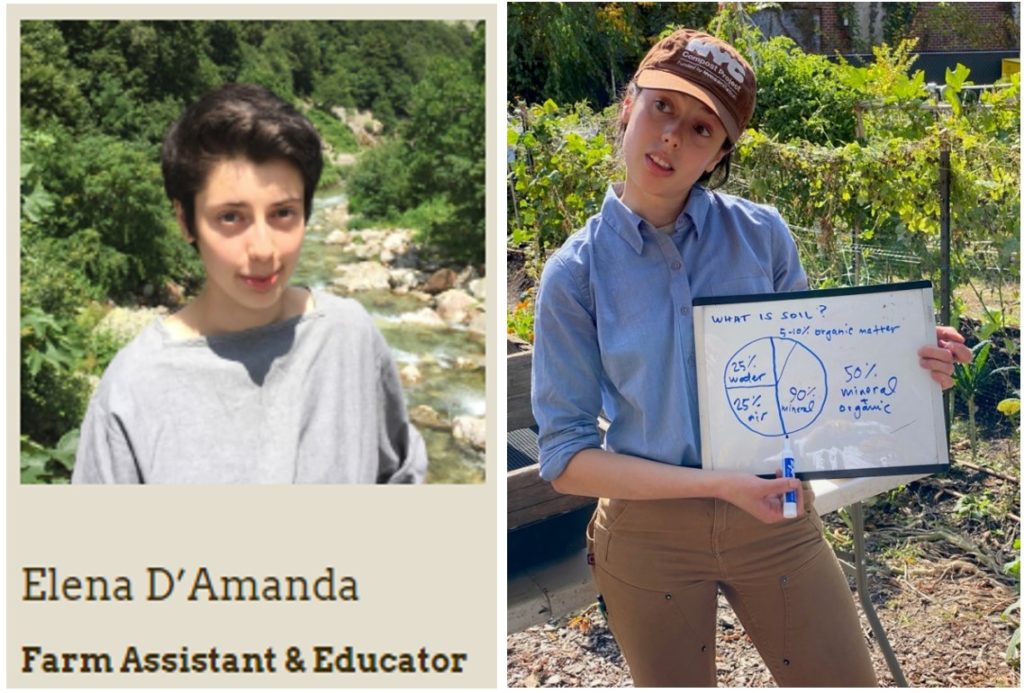
GreenThumb
The Earth Matter Compost and Farm Apprenticeship Program is supported by GreenThumb. GreenThumb supports community gardeners in growing food through educational workshops and materials.
On Graduation Day, Mara Gittleman, Workshops Coordinator of NYC Parks GreenThumb, the community garden office of NYC Parks, and Anthony Reuter, Senior GreenThumb Outreach Coordinator for the Bronx, Manhattan, and Staten Island presented each graduate with a GreenThumb Certificate of Completion as well as an auger and compost thermometer.
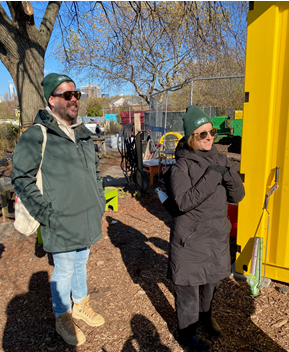
Soil Testing: Heavy Metal Contamination
The 70-hour Earth Matter Compost & Farm Apprenticeship Program is given on Governors Island, NY for 10 weeks in the spring and fall. Apprentices must belong to a GreenThumb community garden. A spring 70-hour course starts in March, a 200-hour program is from April through August, and a Youth Program is in the summer. The fall program I took began on September 10 and ended November 19.
During the course, we each received a badge that let us board first on both the Manhattan and Brooklyn ferries to and from Governors Island and to ride free on the Manhattan ferry. We each also got a pair of shears and a T-shirt. On Graduation Day, we were each shown how to make a leaf/flower press which we took home and were an Earth Matter Certificate of Completion.
We learned the critical importance of getting soil tested. Without finding out if the soil is contaminated with heavy metals, gardeners could grow foods that are harmful. We each got soil from our community garden tested at the Urban Soils Institute which provides free soil testing every month on the third or fourth Saturday from 12-4PM at the Swale House on Governors Island. The soil was tested for five heavy metals: Arsenic (Az), Cadmium (CD), Lead (Pb), Zinc (Zn), and Copper (Cu). When necessary, we were given recommendations on how to improve the quality of the soil and/or remediate heavy metal contamination.
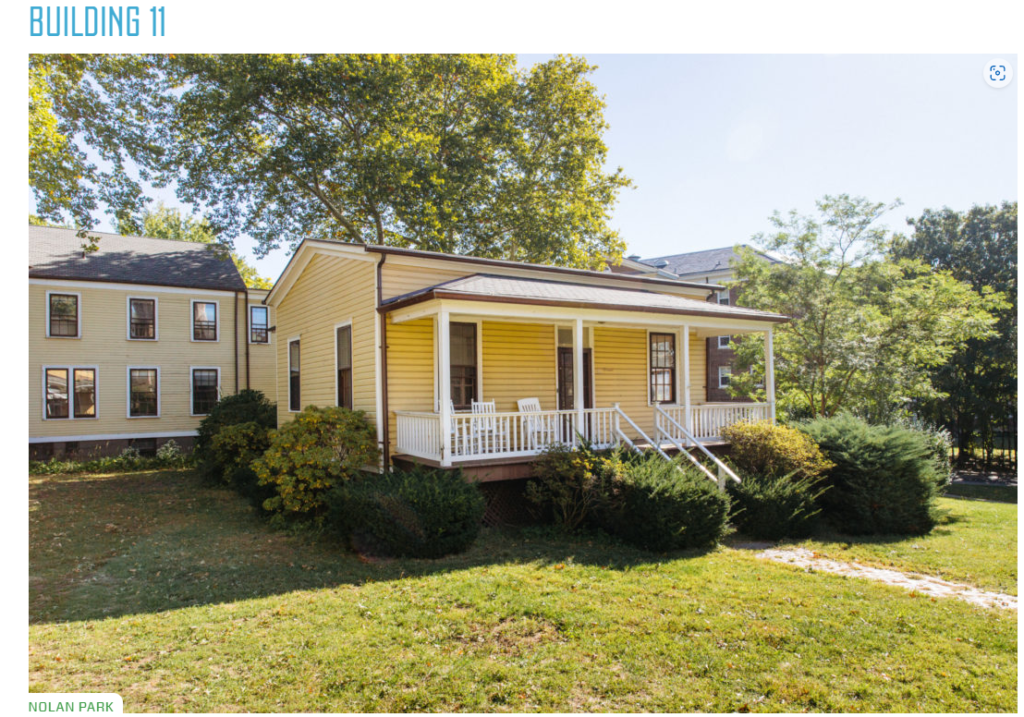
Soil Texture: Sand, Silt, Clay, Loam
We were shown how to test the texture of the soil. Soil texture refers to the amount—and size—of clay, sand, and silt particles in soil. Soil texture determines how much water and nutrients the soil can hold, how fast water will drain, how much air is in the soil, and how deep your grass’s roots will extend.
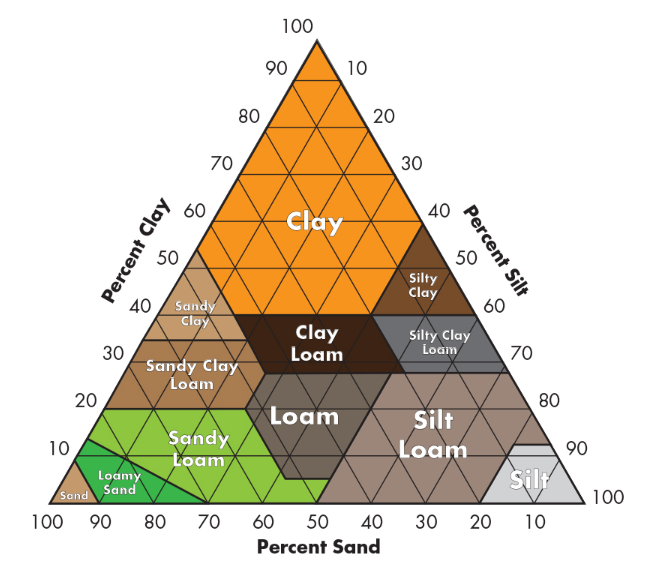
A sandy soil has a lot of great qualities including that it is much more difficult to compact a sandy soil. A sandy soil is much easier to work with than clay soils because it is lighter weight, and is easy to dig in or amend with compost. Most flowering plants benefit from the fact that sand has good drainage quality.
However, sand is composed of silica, usually quartz crystals, and these have relatively no ability to hold onto nutrients and little ability to hold on to water. Water sandy soils less frequently but for longer each time to encourage deeper root systems where more water is available. Because sandy soils have so much more air space than other types of soil, water evaporates from the surface at a much faster rate than clay soils. Applying a 2-3” layer of mulch composed of compost or other organic matter will stop water evaporation almost entirely. This helps keep the water where the plants need it, underground.
Silt particles have a limited ability to retain plant nutrients in the soil. Clay has good retention of plant nutrients. However, clay soils can be compacted with lawn mowers, cars, etc.
Clay, sand, silt, loam: How different soils affect gardens
“You can cure the ills of either clay or sandy soils in basically the same way: with plenty of organic matter. That includes compost, manure, leaves, peat moss, straw, hay, grass clippings, wood chips, and anything else that is or once was living.
As these materials decompose and feed microbes, a witches’ brew of natural compounds is created that affects a soil’s physical, nutritional and biological properties — all for the better. Sandy soils become more spongy so they hold water better, and charged so they retain nutrients. Gums form that stick clay particles together into larger units with larger spaces between them, from which excess water can drain away and let in air.
The ideal soil is not one that is predominantly sand, silt, or clay, but one that has all these particles in amounts that let each express itself. The result is a range of pore sizes, some to hold water and some to hold air. Such soils — the holy grail to gardeners — are called loams.”
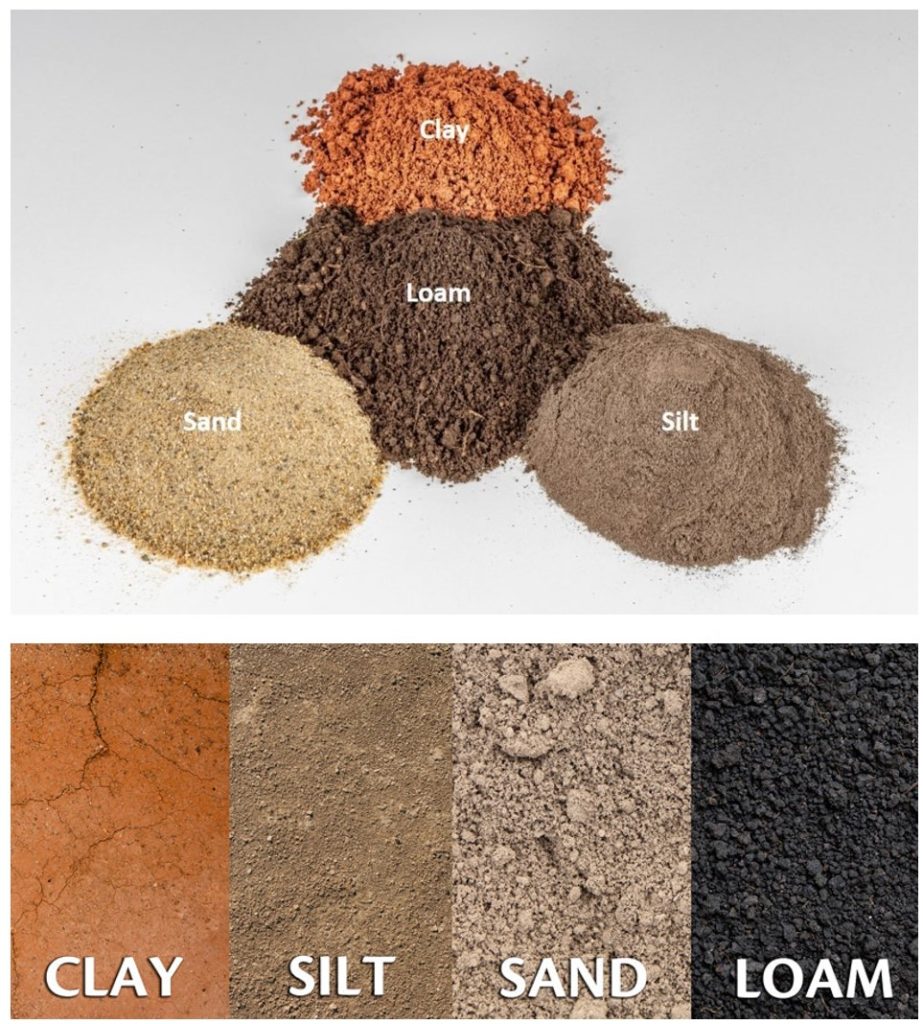
Ph Levels Affect Nutrient Availability
We learned that the pH levels of the soil affect which nutrients are available to plants grown in the soil.
SOIL TESTS 101: HOW TO READ YOUR RESULTS points out:
“The first, and in my opinion, most important thing to look at is the soil pH. If your pH is off, it greatly limits the availability of all other nutrients. Figure 1 below shows the availability of nutrients at different soil pH levels. Let’s use phosphorous (P) as an example. As the pH drops below 6.0, the availability of P quickly diminishes. Phosphorous is an essential macronutirent that our crops need in high amounts to produce a favorable yield. It’s also a nutrient that most farmers have to apply each year to fulfill their crop needs.
If the pH is too low, more P will need to be applied to produce the same result. Most of our row crops prefer a somewhat acidic pH (below 7), but just slightly. Ideally, we want our soil pH to range from 6.3 to 6.7. Keep in mind that the fertilizers we use, specifically ammonia based products like UAN or anhydrous ammonia, will quickly reduce soil pH because they flood the soil with hydrogen (H) ions, which in turn lower the pH. Buffer pH, which is a measure of a soils ability to resist change, is used to determine how much lime is necessary to achieve the desired pH level.”
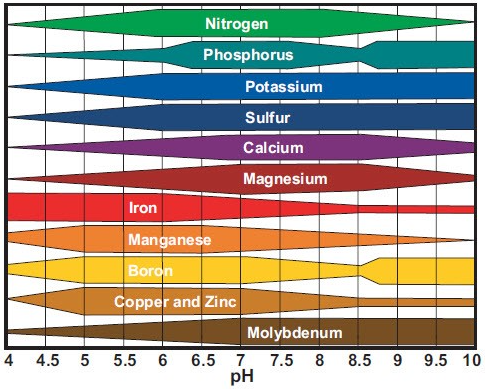
Lasagna Bed To Build Soil
We learned how to create a Lasagna Bed to build soil. Two rows of Lasagna Compost were created next to the rows of corn stalks which were planted in a Lasagna Bed created last year. In the spring, corn will be planted in the new Lasagna Bed. Elena explained that the entire Urban Farm was created from Lasagna Beds!
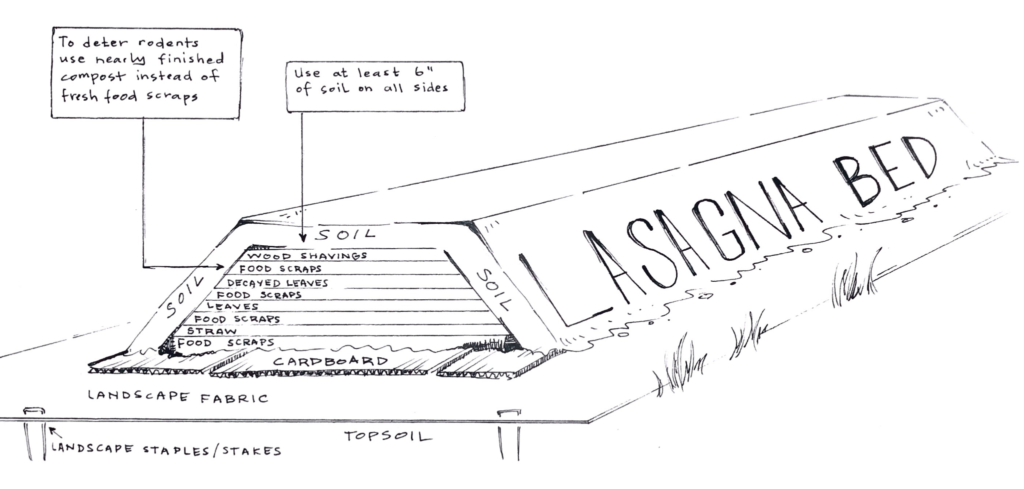
After the cardboard was laid, food scraps were added, topped by straw and more food scraps, followed by two layers of leaves and food scraps, topped with wood shavings, and sealed with a coat of soil.
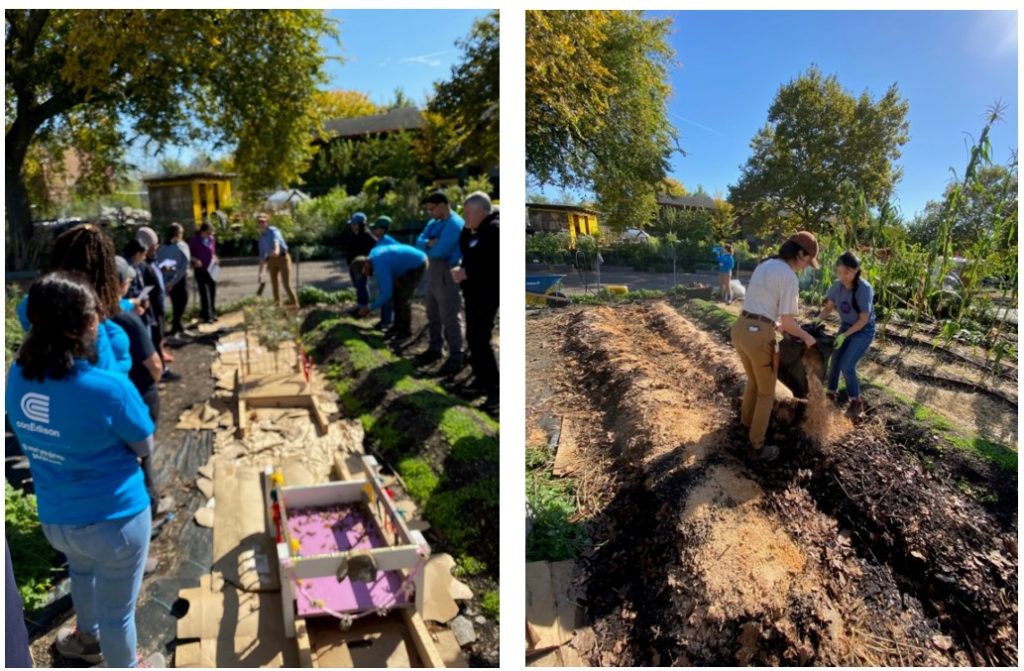
Bokashi Method With Shig Matsukawa
E. Shig Matsukawa of recyclefoodwaste.org, bokashi expert at Recycle Food Waste New York City, led a workshop on bokashi, a method of fermenting food waste. Shig has been a volunteer educator on bokashi composting since 2009. Based in NYC, he provides workshops to community gardens and schools throughout the city. He is mainly involved with El Sol Brillante Community Garden (526 E 12th St) and the Children’s Garden (12th St and Ave B) both in the East Village/Lower East Side of Manhattan. Shig has been studying bokashi and EM (Effective Microorganisms) for years.
Webinar Resources: Using Bokashi in Community Composting — What, Why, How, Who
Several Composting Methods
We were taught many aspects of composting. We divided into three teams of 2-3 people, each of which was responsible for maintaining one of the three types of backyard composting devices: Jora Compost Tumbler, Mantis Compost Tumblers, and two garbage cans with holes punched in them.
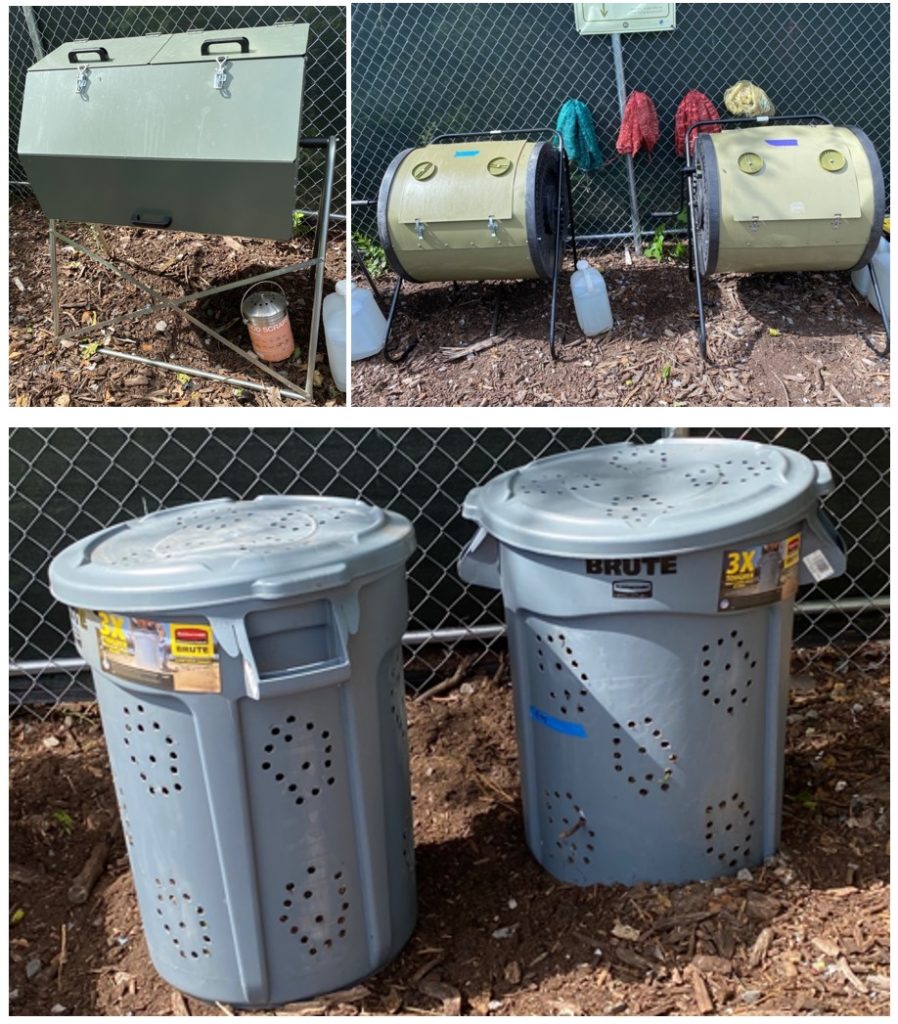
Foraging: The Honorable Harvest
Each Apprentice probably has a different favorite part of the 10-week program. The most revolutionary aspect of the Apprenticeship for me was that before we went foraging in Week 6, we were asked to watch the video below in which Professor Robin Kimmerer discusses the concept of “The Honorable Harvest” which is basic to the Native American approach to nature.
The Honorable Harvest with Robin Kimmerer
“What does ethical reciprocity between humans and the natural world look like? The Honorable Harvest reminds us how to take, use and share while mindfully honoring the indigenous legacies that teach us how to commune with our planet. Featuring Robin Wall Kimmerer, Professor of Environmental and Forest Biology at the State University of New York College of Environmental Science and Forestry.”
The “Honorable Harvest”: Lessons From an Indigenous Tradition of Giving Thanks
“The Honorable Harvest, a practice both ancient and urgent, applies to every exchange between people and the Earth. Its protocol is not written down, but if it were, it would look something like this:
Ask permission of the ones whose lives you seek. Abide by the answer.
Never take the first. Never take the last.
Harvest in a way that minimizes harm.
Take only what you need and leave some for others.
Use everything that you take.
Take only that which is given to you.
Share it, as the Earth has shared with you.
Be grateful.
Reciprocate the gift.
Sustain the ones who sustain you, and the Earth will last forever.”
Braiding Sweetgrass
After watching the video, I bought Professor Kimmerer’s book Braiding Sweetgrass: Indigenous Wisdom, Scientific Knowledge and the Teaching of Plants. It is the most beautiful book I’ve ever read. Wikipedia says:
“Braiding Sweetgrass: Indigenous Wisdom, Scientific Knowledge, and the Teachings of Plants received the 2014 Sigurd F. Olson Nature Writing Award. By 2021, over 500,000 copies had been sold worldwide…. In 2022 Dr. Kimmerer was awarded the Macarthur ‘genius’ award.”
The book has been a word-of-mouth best seller and hit the New York Times Best Seller List.
 BRAIDING SWEETGRASS INDIGENOUS WISDOM, SCIENTIFIC KNOWLEDGE AND THE TEACHINGS OF PLANTS
BRAIDING SWEETGRASS INDIGENOUS WISDOM, SCIENTIFIC KNOWLEDGE AND THE TEACHINGS OF PLANTS
Robin Kimmerer is a professor at the State University of New York College of Environmental Science and Forestry. She is a member of the Potawatomi Tribe ) “People of the Place of the Fire” and spoke a few words in the Potawatomi language, a member of the Algonquin family. The Citizen Potawatomi Nation is the federally-recognized government and represents over 37,000 tribal members. It acts under a ratified Constitution and includes executive, legislative, and judicial branches. The Potawatomi are located in the western Great Lakes region, upper Mississippi River, and Great Plains.
Robin Kimmerer – Mishkos Kenomagwen: The Teachings of Grass | Bioneers
“Indigenous peoples worldwide honor plants, not only as our sustainers, but as our oldest teachers who share teachings of generosity, creativity, sustainability, and joy. By their living examples, plants spur our imaginations of how we might live. By braiding indigenous Traditional Ecological Knowledge (TEK) with modern tools of botanical science, Robin Kimmerer, professor of Environmental Science and Forestry, of Potawatomi ancestry, explores the question: ‘If plants are our teachers, what are their lessons, and how might we become better students’?”
“Robin Wall Kimmerer is a mother, scientist, decorated professor, and enrolled member of the Citizen Potawatomi Nation. She is the author of Braiding Sweetgrass: Indigenous Wisdom, Scientific Knowledge and the Teaching of Plants and Gathering Moss: A Natural and Cultural History of Mosses. She lives in Syracuse, New York, where she is a SUNY Distinguished Teaching Professor of Environmental Biology, and the founder and director of the Center for Native Peoples and the Environment.”
Professor Kimmerer advises that to become “indigenous” to where you live, pay more attention to your surroundings outdoors. That led me to see trees in my neighborhood that I had not noticed for decades. I decided that next fall, I will collect a variety of beautiful leaves and preserve them.
 Gathering Moss: A Natural and Cultural History of Mosses
Gathering Moss: A Natural and Cultural History of Mosses
The Original Instructions
Professor Kimmerer’s videos and book inspired me to write Mapping a New Geography of Hope With Native America which is included in My Articles About Native America on my Urban Gardens Revolution site. The articles show that the profound connection to the land Native American cultures have maintained is our best guide to avoid the Sixth Mass Extinction now. We have just 6 inches of top soil left now — enough to grow food for just 60 years!
In the 2008 video Indigenous Native American Prophecy, actor Floyd Red Crow Westerman said Native Americans were told they would see America come and go. He said, “In a sense, America is dying from within because they forgot the instructions on how to live on Earth”. He warned that people who do not know how to live spiritually on Earth likely will not make it. He explained that when Columbus came, that started the true First World War. By WWII, the indigenous population of the Americas had dropped from 60 million to 800,000! The Native American population in the US is currently 4.5 million.
 Original Instructions: Indigenous Teachings for a Sustainable Future
Original Instructions: Indigenous Teachings for a Sustainable Future
Overcoming ‘Place Blindness’: How to Connect with the Land You Live On
“Rewilding allows you to see your environment with new eyes, sometimes as if for the very first time. You become more intimate with all its life-forms and sometimes see beyond the visible, connecting with a greater presence. In his book The Nature Principle, Richard Louv discusses ‘place blindness,’ which afflicts people who live so much of their lives indoors or in front of screens that they do not look up to notice the land they live on….
Because place blindness inevitably leads to a disconnection with the living earth, it also leads to a lack of caring and interest in the planet’s well-being. Future generations will not value and care for the earth if they have little or no actual relationship with it.…
The more time we spend out on the land, exploring and learning about the different plants and animals, the natural history and ecology, and simply enjoying and getting to know the contours of the living earth, the more bonded we’ll feel to the places we call home. The more intimate we become with the land, the more we’ll grow to love and cherish it.”
My Articles About Native America in my Urban Gardens Revolutions site shows that a growing number of Native Americans are stepping forward now to help guide humanity from the brink. We just have to be wise enough now to listen and learn to follow.
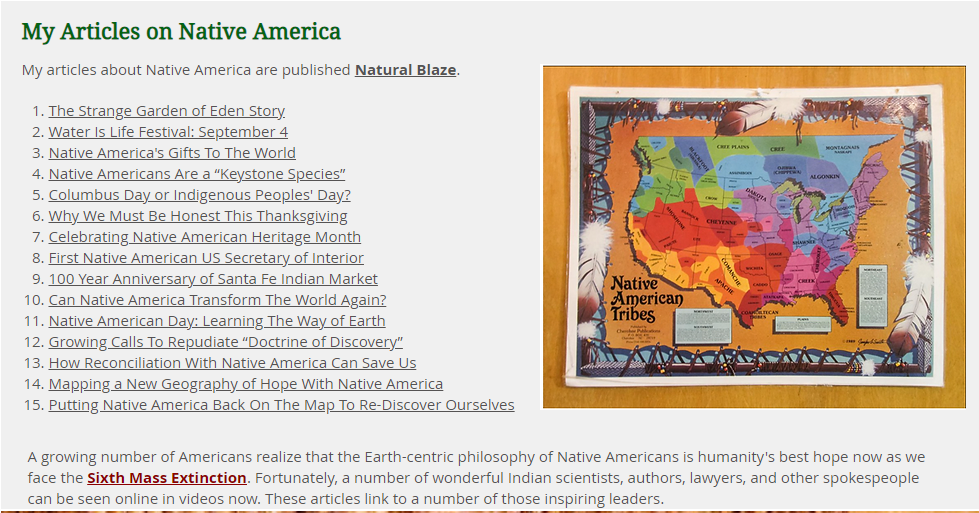

Foraging: DVD and Books
Foraging is an easy way to learn more about an area and to become more food secure. It’s a return to hunting and gathering that allows us to get free food throughout much of the year. Foraging With “Wildman” Steve Brill and Violet describes my foraging trip in December 2021 with Steve Brill and his daughter Violet in Prospect Park, NY. Steve provides tours in the New York City area from March to early December. Steve says he has enough foraged food in his freezer to last two years!
You can purchase Steve’s DVD Foraging With The Wildman on his site which links to his three books shown below. Note: Steve signs books purchased from his site. Steve’s site has many delicious recipes. Under “Foraging”, Steve lists Wild Foods and Wild Mushrooms with lots of information about each.
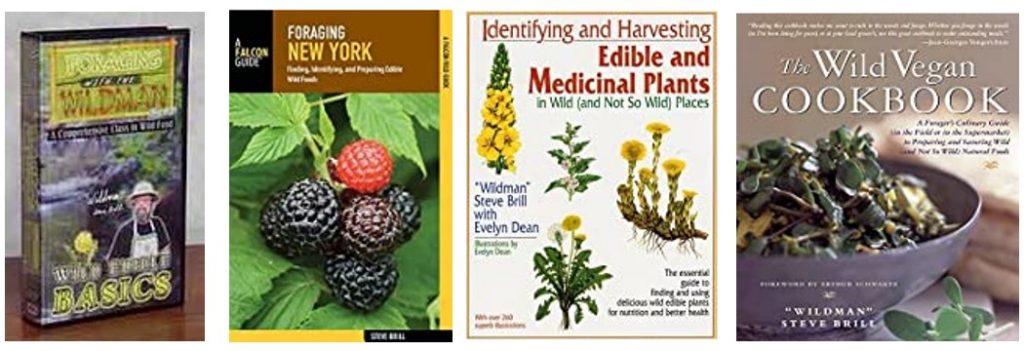
The Apprenticeship introduced the two books below.
 Botany in a Day: The Patterns Method of Plant Identification
Botany in a Day: The Patterns Method of Plant Identification
 Northeast Foraging: 120 Wild and Flavorful Edibles from Beach Plums to Wineberries (Regional Foraging Series)
Northeast Foraging: 120 Wild and Flavorful Edibles from Beach Plums to Wineberries (Regional Foraging Series)
Next Steps
1 – December: Windrow: Each Tuesday in December, instead of helping with composting, I am helping my community garden build a windrow for the AgBed.
2 – January: Carpentry: I plan to register for the January 28 Carpentry session on Governors Island. Marisa recommended two books: Reader’s Digest new complete do-it-yourself manual and Beginners Guide To Woodworking: An Introduction To Basic Hand Tools, Equipment, And Techniques In Starting Your Woodworking Journey Paperback which I bought.

3 – March: Soil Testing: At the suggestion of the head of composting in my garden, I am going to offer to get the soil tested on Governors Island for anyone in the garden who has a plot.
4 – April: Foraging: Foraging With “Wildman” Steve Brill in Central Park documents my foraging trip with Steve in Central Park on December 4. One Apprentice joined us. Members of my community garden expressed interest in having a small continent go foraging with Steve. My next foraging trip will be on Earth Day (April 22) in Central Park at Fifth Avenue and 106th Steve’s site says: “Central Park provides a great window into the world of wild foods in early spring. Making a meal with these plants is simple at this time of the year.”
5 – June: Lavender Festival: I plan to visit the Lavender Fields on Governors Island during the Lavender Festival on June 18-19.

6 – Fall: It’s really fun to be able to eat for free from the land! I went back to Central Park on December 10 and gathered more Gingko biloba nuts to roast! I plan to get lots of Gingko nuts from the park in my neighborhood next fall. I also plan to gather the Honey Locust pods in my neighborhood and sample the sweet goo inside and the seeds.
7 – “Picture This” App: The Picture This app was recommended by one of the Apprentices. It’s the best app for identifying plants I’ve seen. I’m using it to identify leaves from trees in my neighborhood and it is much better than five books I bought about NYC trees! Next fall, I plan to label leaves and preserve them in wax. Being able to identify them is key to that step.

8 – “Merlin Bird ID” App: The Merlin Bird ID app makes it easy to take a photo of any bird and identify it. It even plays the song each bird sings! I took the photos below of a Northern Cardinal and European Starling in Central Park and used the app to ID them.

Both these apps make it easy to get to know your area better. They help you “rewild” and become more “indigenous” as Prof. Kimmerer recommends.
Flip Books For Apprenticeship Program
The Flip Books on my Urban Gardens Revolution site document my experience with the Apprenticeship Program. When you get to the end of Book 1, you can click through to Book 2.

Neenah Payne writes for Activist Post and Natural Blaze
Top image: Kripalu


